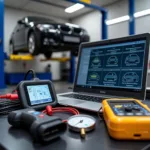A car diagnostic tool linking error occurs when your diagnostic tool fails to establish a proper connection with your vehicle’s onboard computer. This frustrating issue can prevent you from reading and clearing trouble codes, hindering your ability to diagnose and repair car problems.
Common Causes of Car Diagnostic Tool Linking Errors
Several factors can contribute to car diagnostic tool linking errors. Understanding these causes is crucial in finding the right solution for your specific situation. Here are some of the most common culprits:
- Faulty OBD-II Port or Cable: A damaged, loose, or corroded OBD-II port or a faulty diagnostic cable can disrupt communication between the tool and the vehicle’s computer.
- Incompatible Diagnostic Tool: Not all car diagnostic tools are compatible with all vehicle makes and models. Using an incompatible tool can lead to communication issues, including linking errors.
- Software or Firmware Issues: Outdated or corrupted software or firmware in the diagnostic tool or the vehicle’s computer can cause compatibility problems and trigger linking errors.
- Blown Fuse: A blown fuse related to the OBD-II port or the vehicle’s communication systems can interrupt the flow of information and result in a linking error.
- Low Battery Voltage: Insufficient battery voltage can disrupt the communication between the diagnostic tool and the vehicle’s computer, leading to a linking error.
Troubleshooting Car Diagnostic Tool Linking Errors
Experiencing a car diagnostic tool linking error can be frustrating, but don’t panic! Here’s a step-by-step guide to help you troubleshoot the issue:
-
Check the OBD-II Port and Cable: Begin by visually inspecting the OBD-II port for any signs of damage, debris, or loose connections. Ensure the diagnostic cable is securely connected to both the tool and the port. If you suspect a faulty cable, try using a different one.
-
Verify Compatibility: Double-check that your car diagnostic tool is compatible with your vehicle’s make, model, and year. Consult the tool’s documentation or manufacturer’s website for compatibility information.
-
Update Software and Firmware: Ensure both your car diagnostic tool and your vehicle’s software and firmware are up to date. Outdated software can lead to compatibility issues and communication errors.
-
Inspect Fuses: Consult your vehicle’s owner’s manual to locate the fuse box and identify the fuse associated with the OBD-II port or related communication systems. Check the fuse for any signs of damage or a blown filament. If necessary, replace the fuse with a new one of the correct amperage.
-
Check Battery Voltage: Use a multimeter to check the voltage of your car battery. A low battery voltage can disrupt communication between the diagnostic tool and the vehicle’s computer. If the battery is low, charge it fully before attempting to establish a connection again.
“When troubleshooting linking errors, always start with the basics like checking the OBD-II port and cable. You’d be surprised how often a simple loose connection is the culprit,” advises John Miller, a seasoned automotive diagnostician with over 20 years of experience. “Also, don’t underestimate the importance of keeping your diagnostic tool’s software and firmware updated to ensure compatibility with the latest vehicle models.”
When to Seek Professional Help
If you’ve exhausted all troubleshooting steps and are still unable to resolve the car diagnostic tool linking error, it might be time to seek professional assistance. A qualified automotive electrician or mechanic can diagnose the issue more thoroughly and determine if there are any underlying electrical problems or more complex issues with your vehicle’s communication systems.
Conclusion
A car diagnostic tool linking error can be a roadblock to effectively diagnosing and repairing your vehicle. By understanding the common causes and following the troubleshooting steps outlined in this article, you can often resolve the issue yourself. However, don’t hesitate to seek professional help if the problem persists. Remember, timely diagnosis and repair are crucial for maintaining the health and longevity of your vehicle.


